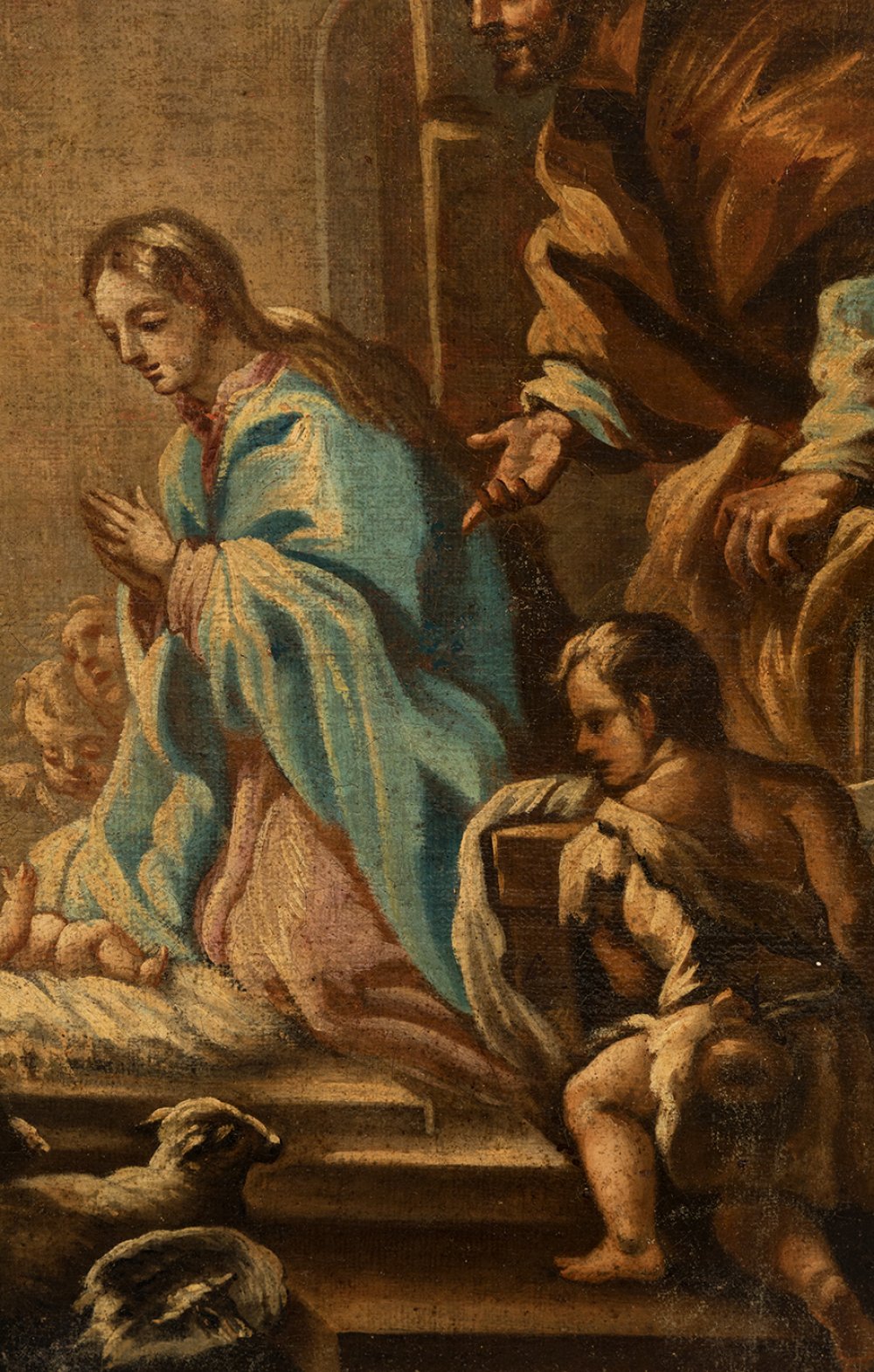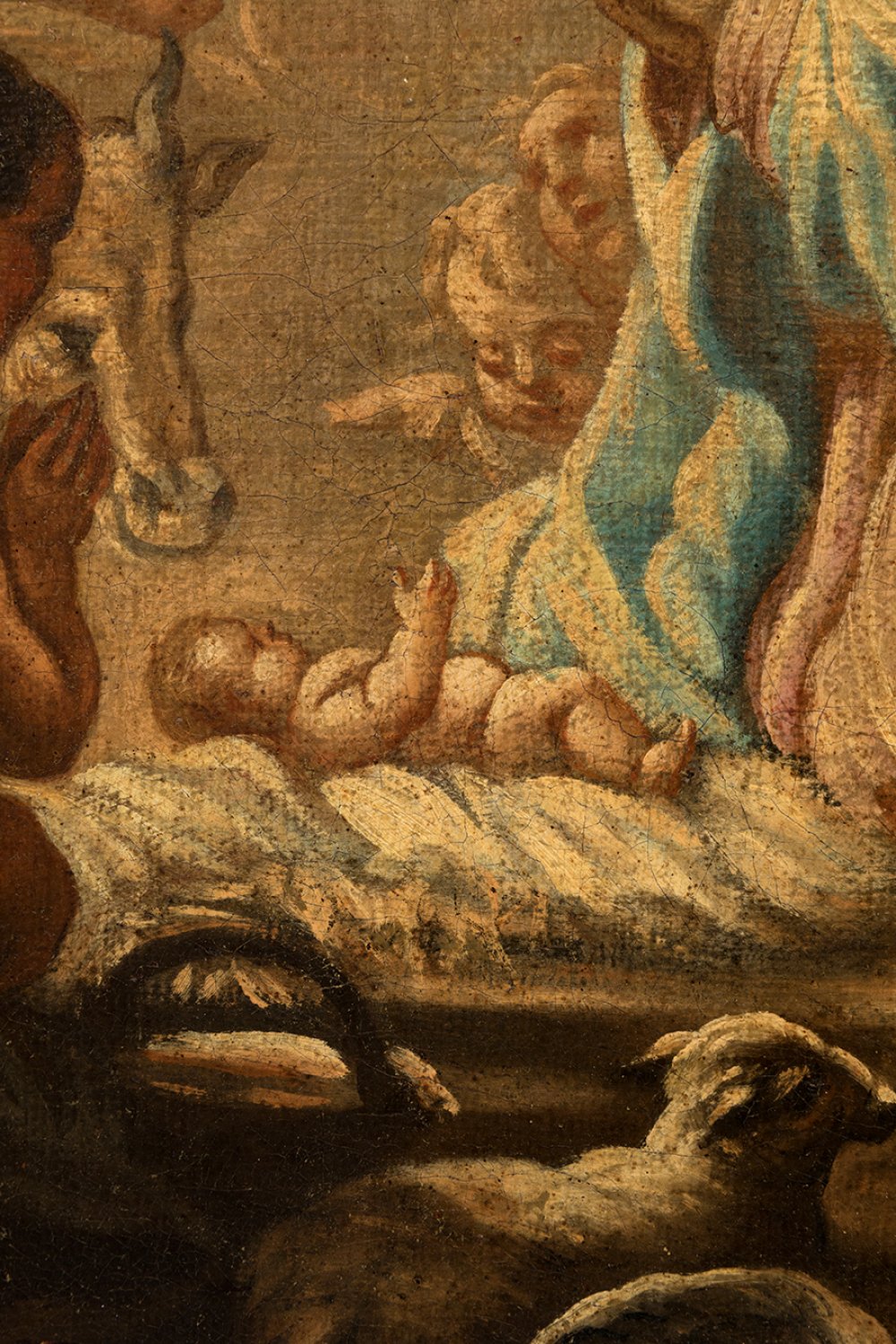1
School of LUCA GIORDANO (Naples, 1634 - 1705)."Adoration of the Shepherds.Oil on canvas. Re-framed.
"Adoration of the Shepherds.
Oil on canvas. Re-framed.
It has a 20th century frame.
Measurements: 82 x 61 cm; 104 x 81 cm (frame).
This canvas represents a classic theme in the History of Art, that of the shepherds adoring the new-born baby Jesus in the Bethlehem's portal. It is a scene that lends itself to being interpreted as a large composition with numerous characters, worked in a costumbrista style, and was therefore very much to the taste of Baroque painters, who sought above all a natural and intimate art that would move the faithful and make them feel close to what was represented on the canvas, to the sacred story. Thus, the divine elements are reduced to a minimum, with only a Glory break in the upper part, with two child angels attending the event. As is typical of the early Baroque, this heavenly space is clearly differentiated from the earthly one, a clear separation which, however, disappeared in the second Baroque.
This work fits into the aesthetic patterns of the work of Luca Giordano, the most important Neapolitan painter of the late 17th century and one of the main representatives of the late Italian Baroque. A painter and engraver known in Spain as Lucas Jordán, Giordano enjoyed great popularity during his lifetime, both in his native Italy and in Spain. However, after his death his work was often criticised for its speed of execution, which was at odds with the Greco-Latin aesthetic. It is thought that he trained in the circle of Ribera, whose style he initially followed. However, he soon travelled to Rome and Venice, where he studied Veronese, whose influence is evident in his work. This trip was key to the maturing of his style, as were the influences of other artists such as Mattia Preti, Rubens, Bernini and, above all, Pietro da Cortona. In the late 1670s Giordano began his large-scale mural decorations (Montecassino and San Gregorio Armeno in Naples), followed from 1682 onwards by other projects, including the mural paintings in the gallery and library of the Palazzo Medici Ricardi in Florence. In 1692 he was called to Madrid to paint murals in the monastery of El Escorial, where he worked from 1692 to 1694. He then executed the paintings of the office and bedroom of Charles II in the Royal Palace of Aranjuez, and after these he undertook the paintings of the Casón del Buen Retiro (ca. 1697), the sacristy of Toledo cathedral (1698), the royal chapel of the Alcázar and San Antonio de los Portugueses (1699). However, royal commissions ceased with the arrival of Philip V in 1701 and the beginning of the War of the Spanish Succession, and Giordano returned to Naples in 1702, although he continued to send paintings to Spain from there. Today Giordano's works are housed in the most important art galleries throughout the world, including the Prado, the Hermitage in Saint Petersburg, the Louvre in Paris, the Kunsthistorisches in Vienna, the Metropolitan in New York and the National Gallery in London.
"Adoration of the Shepherds.
Oil on canvas. Re-framed.
It has a 20th century frame.
Measurements: 82 x 61 cm; 104 x 81 cm (frame).
This canvas represents a classic theme in the History of Art, that of the shepherds adoring the new-born baby Jesus in the Bethlehem's portal. It is a scene that lends itself to being interpreted as a large composition with numerous characters, worked in a costumbrista style, and was therefore very much to the taste of Baroque painters, who sought above all a natural and intimate art that would move the faithful and make them feel close to what was represented on the canvas, to the sacred story. Thus, the divine elements are reduced to a minimum, with only a Glory break in the upper part, with two child angels attending the event. As is typical of the early Baroque, this heavenly space is clearly differentiated from the earthly one, a clear separation which, however, disappeared in the second Baroque.
This work fits into the aesthetic patterns of the work of Luca Giordano, the most important Neapolitan painter of the late 17th century and one of the main representatives of the late Italian Baroque. A painter and engraver known in Spain as Lucas Jordán, Giordano enjoyed great popularity during his lifetime, both in his native Italy and in Spain. However, after his death his work was often criticised for its speed of execution, which was at odds with the Greco-Latin aesthetic. It is thought that he trained in the circle of Ribera, whose style he initially followed. However, he soon travelled to Rome and Venice, where he studied Veronese, whose influence is evident in his work. This trip was key to the maturing of his style, as were the influences of other artists such as Mattia Preti, Rubens, Bernini and, above all, Pietro da Cortona. In the late 1670s Giordano began his large-scale mural decorations (Montecassino and San Gregorio Armeno in Naples), followed from 1682 onwards by other projects, including the mural paintings in the gallery and library of the Palazzo Medici Ricardi in Florence. In 1692 he was called to Madrid to paint murals in the monastery of El Escorial, where he worked from 1692 to 1694. He then executed the paintings of the office and bedroom of Charles II in the Royal Palace of Aranjuez, and after these he undertook the paintings of the Casón del Buen Retiro (ca. 1697), the sacristy of Toledo cathedral (1698), the royal chapel of the Alcázar and San Antonio de los Portugueses (1699). However, royal commissions ceased with the arrival of Philip V in 1701 and the beginning of the War of the Spanish Succession, and Giordano returned to Naples in 1702, although he continued to send paintings to Spain from there. Today Giordano's works are housed in the most important art galleries throughout the world, including the Prado, the Hermitage in Saint Petersburg, the Louvre in Paris, the Kunsthistorisches in Vienna, the Metropolitan in New York and the National Gallery in London.
7th September - Old Masters
Sale Date(s)
Venue Address
General delivery information available from the auctioneer
Setdart offers Worldwide shipping
PICK UP IN ROOM: You can come and pick up your lots in our offices (Barcelona, Madrid or Valencia). At the moment of the withdrawal, you will be able to accept the current conditions of the lot by means of a document that you will sign.
YOU CAN SEND ANOTHER PERSON TO PICK UP: This person must present a signed authorization that you can find in our web page by accessing from BUY AT SETDART- LOGISTICS-DOWNLOAD AUTHORIZATION DOCUMENT. You can also send an e-mail with the requested data in AUTHORIZATION DOCUMENT to admin@setdart.com
Important Information
25% buyer´s premium
21% buyer´s premium at www.setdart.com
Terms & Conditions
The maximum period to pay the lots is 7 working days. You can pay either via bank transfer or with credit card through our platform www.setdart.com (we only accept VISA or Mastercard).
BUYER´S PREMIUM: 22% Hammer price + 21% VAT from the buyer´s premium
If your piece has more than 100 years, our Ministry of Culture requires an export certificate in order for the piece to leave the country. Note that if the piece goes inside the EU, there is no cost for the export certificate. If the piece goes outside the EU, there is a cost for the export certificate. You can find more information in our Ministry of Culture website: https://www.culturaydeporte.gob.es/en/cultura/patrimonio/exportacionimportacion/exportacion/tasas.html
INQUIRIES: admin@setdart.com
Setdart guides you through the entire process, from the time of award to the day you receive your lot. Our logistics team will be happy to manage your transport, and will advise you on the best shipping method with professionals from the sector used to handling works of art and jewelry.
WE OFFER WORLDWIDE DOOR TO DOOR SHIPPING
PICK UP IN ROOM: You can come and pick up your lots in our offices. At the moment of the withdrawal, you will be able to accept the current conditions of the lot by means of a document that you will sign.
YOU CAN SEND ANOTHER PERSON TO PICK UP: This person must present a signed authorization that you can find in our web page by accessing from BUY AT SETDART-LOGISTICS-DOWNLOAD AUTHORIZATION DOCUMENT. You can also send an e-mail with the requested data in AUTHORIZATION DOCUMENT to admin@setdart.com
SETDART IS NOT RESPONSIBLE FOR THE STATE OF THE PARTS ONCE THEY LEAVE OUR FACILITIES. MRW SHIPMENTS: Once the payment is made, your lot will be packed for shipment, the logistics department will send you an e-mail notifying you of the day it leaves our warehouse, changes of address cannot be made after receiving this e-mail.
INSURANCE INCIDENTS: Coverage for the value of the auction up to 3000 ? per shipment, if the value of the auction is higher, Setdart will send you a quote including the additional insurance. The insurance company WILL NOT BE RESPONSIBLE FOR THE SHIPMENT THAT EXCEEDS THAT AMOUNT AND IS NOT FULLY INSURED. MRW INCIDENTS: Maximum notification 48 hours after receipt, after which the insurance company WILL NOT BE RESPONSIBLE AND NO CLAIMS WILL BE ACCEPTED.
E-MAIL LOGISTICS: logistica@setdart.com
PICK UP YOUR MESSAGES: You can send your own messaging, prior notice via e-mail that your shipment is ready, please note 3 or 4 days in advance. This type of shipment is packaged so Setdart will provide you with a quote.
EXPENSES FOR STORAGE: We inform you that if the purchased lot is not picked up within a month, you will be charged 30€ per week per lot. Setdart Online S.L., owner of the web site "setdart.com", "setdart.net" and "setdart.org", acts as a company of Spanish nationality inscribed in the Volume 36955, sheet 182, page B-293056 of the Mercantile Registry, with registered office at Calle Aragó















